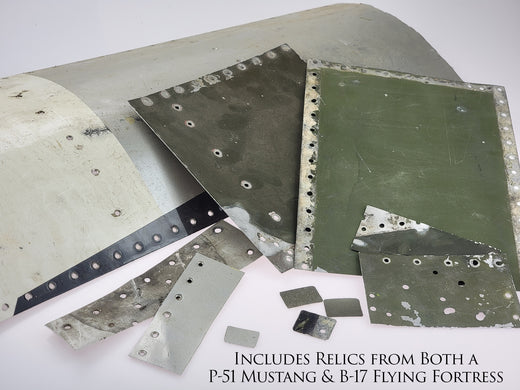This Fine Art Print by Artist Craig Tinder illustrates the return trip of a B-17G Flying Fortress across the English Channel - escorted by a "Little Friend", a watchful P-51D Mustang - and INCLUDES 2 RELICS!
Details about the RELICS:
B-17G Flying Fortress:
This B-17G Flying Fortress wing skin originated from B-17G-95-DL 44-83872 (BuNo. 77235), known as "Texas Raiders" during a significant wing spar restoration in 2001. This particular artifact originated from the outer wing segment of the port wing. The artist was a Loadmaster and restorer of this aircraft and personally acquired this material during these restoration efforts.
 Artist Craig Tinder with "Texas Raiders" during the Wings Over Houston Air Show
Artist Craig Tinder with "Texas Raiders" during the Wings Over Houston Air Show
 B-17G-95-DL 44-83872 aluminum panels removed during restoration process
B-17G-95-DL 44-83872 aluminum panels removed during restoration process
P-51D Mustang:
This particular fragment of a P-51D-25-NA Mustang came from the fuselage panel of aircraft 44-73990 (Construction No. 122-40530). Built in 1944, it initially served with the US Army Air Force before being transferred to the Royal Canadian Air Force in 1951.
After changing hands several times, the aircraft eventually joined the air racing circuit under the name "Pigeon Chaser." It was flown by the legendary R.A. "Bob" Hoover as the pace plane for the 1971 Cape May National Air Races.
From 2000 to 2015, the aircraft underwent extensive restoration and is now painted in the livery of "Alabama Rammer Jammer," representing the 353rd Fighter Group, the same unit featured in the artwork.
 Aluminum skin panels from P-51D-25-NA 44-73990
Aluminum skin panels from P-51D-25-NA 44-73990
The Story Behind the Print:


This artwork, titled "Homeward Bound," captures a poignant moment during World War II when Lt. Col. William B. Bailey, piloting his P-51D Mustang "Double Trouble Two," escorted the B-17G Flying Fortress "Shady Lady" across the English Channel.
As part of the 352nd Fighter Squadron, 353rd Fighter Group, Bailey and his fellow Mustang pilots often served as protective escorts for bomber crews returning from dangerous missions over Europe.
The powerful image of the sleek Mustang flying alongside the mighty B-17G symbolizes both the teamwork and sacrifice of these brave airmen during the war.
Learn more about Was the B-24 better than the B-17? Click Here
To purchase or see similar items, visit here.
Commissioned by Museums, Treasured by Collectors





Share:
Combat Strategist, the story behind "Jagdgeschwader 51"
Ace Over England, the story behind "Invaders Across the Channel"